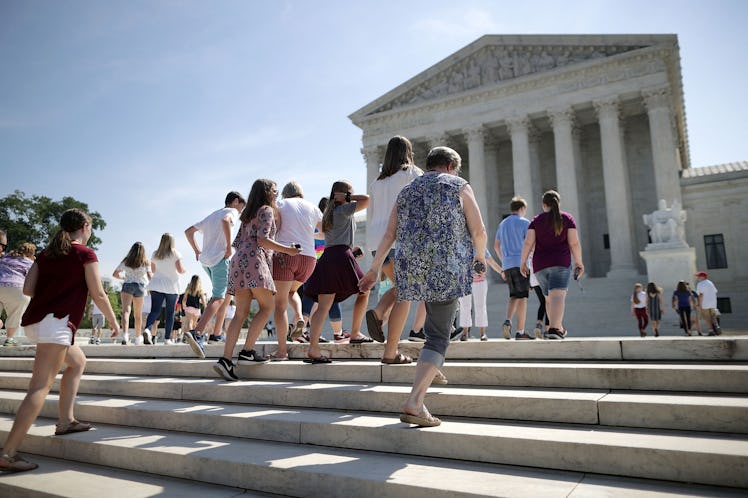
The Supreme Court Made Their Ruling On Trump's Travel Ban
Eighteen months after President Donald Trump signed his first travel ban, the nation's highest court on Tuesday, June 26, ruled to uphold the ban. The Supreme Court's decision on Trump's travel ban is here, and the 5-4 decision effectively vindicates one of Trump's first pieces of executive legislation. The opinion was written by Chief Justice John Roberts, joined by Justices Clarence Thomas, Anthony Kennedy, Samuel Alito, and Neil Gorsuch.
In the ruling, the majority decided that President Trump "lawfully exercised the broad discretion granted to him under Section 1182(f) to suspend the entry of aliens into the United States." (That section of the U.S. Code states that if the president finds that any people or group of people coming to the country "would be detrimental to the interests of the United States, he may by proclamation, and for such period as he shall deem necessary, suspend the entry of all aliens or any class of aliens as immigrants or nonimmigrants, or impose on the entry of aliens any restrictions he may deem to be appropriate.")
Two dissents were written to the majority opinion. One, by Justice Stephen Breyer, was joined by Justice Elena Kagan and explores the idea of the motivation and actual implementation of the travel ban. Ultimately, Breyer's dissent says he would "find the evidence of anti-religious bias, including statements on a website taken down only after the President issued two executive orders preceding the proclamation," referring to a page on Trump's campaign website that called for "a total and complete shutdown of Muslims entering the United States," which was deleted in May 2017.
Another dissent, by Justice Sonia Sotomayor, was joined by Justice Ruth Bader Ginsburg. Her opinion also spoke to the apparent anti-Muslim bias in Trump's creation of the travel ban, stating that "unrebutted evidence actually shows is that a reasonable observer would conclude, quite easily, that the primary purpose and function of the proclamation is to disfavor Islam by banning Muslims from entering our country." In making her case, she walked through Trump's statements on banning Muslims from the country, both as a presidential candidate and as the president.
Indeed, the travel ban, aptly, has had a well-traveled history. One day after Trump signed the executive order, a New York federal judge temporarily blocked part of it, per CNN. The order halted all refugee admissions and temporarily barred people from seven Muslim-majority countries, per BBC News — drawing protests at several major airports. The Hill reported that the first travel ban disallowed people from Iraq, Iran, Syria, Yemen, Libya, Sudan, and Somalia from entering the U.S. for 90 days; halted the U.S. refugee resettlement program for 120 days; and indefinitely suspended resettlement of refugees from Syria. It also reduced the cap on the number of refugees that can be accepted into the U.S. to 50,000 in 2017.
U.S. Judge Ann M. Donnelly ruled that claims the executive order "violates their rights to Due Process and Equal Protection guaranteed by the United States Constitution" would likely be successful, per CNN. Other judges followed suit, to Trump's chagrin, issuing restraining orders in the days that followed.
Trump released a statement attempting to clarify that the original travel ban was not meant to be about religion, but was about preventing terrorism. He wrote on Facebook,
America is a proud nation of immigrants and we will continue to show compassion to those fleeing oppression, but we will do so while protecting our own citizens and border ... The seven countries named in the Executive Order are the same countries previously identified by the Obama administration as sources of terror. To be clear, this is not a Muslim ban, as the media is falsely reporting.
But even Trump's silver tongue could not erase things that he had already implied on the campaign trail, as well as the questionable claim that this would make the country safer, in practice. Trump revised travel ban in March 2017, exempted Iraq from the list, but the legal kerfuffle endured. Attorneys for Hawaii filed the first lawsuit against the new travel ban, per CNN. The lawsuit asked a federal judge to issue a temporary restraining order blocking implementation of the new executive order. Months later, several lawyers and judges weighed in on whether Trump's previous rhetoric should be considered in determining the legality of the travel ban and wondered whether his mindset could be determined based on that, per CNN.
"What do we do," Judge James A. Wynn asked at a December 2017 hearing per CNN, when we have "multiple instances" when the president has tweeted about Muslims "before the election, during the election and just a week or so ago? Do we just ignore reality?" (Trump had recently retweeted inflammatory videos from a British far-right account with anti-Muslim content.)
Yet another version of the travel ban, enacted as a presidential proclamation, emerged in September 2017 — which is the version that was kicked up to the Supreme Court. In April of this year, the five-member conservative majority seemed to indicate that it was prepared to approve a revised version of the president’s plan, according to a report from The New York Times. Attorneys for the administration argued that the latest order was the product of careful study by several agencies into the security and information-sharing practices of countries worldwide, per The Times, urging the courts to disregard Trump’s statements and Twitter posts.
Now, the official Supreme Court ruling has come in, with the conservative majority winning out in granting Trump's travel ban legitimacy — but not without loud dissent from the liberal justices.